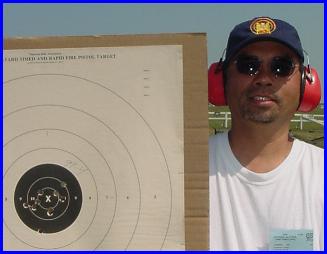
Greetings Shooters,
We've had on-going discussions in the Bullseye-L Internet Forum regarding sighting questions. In fact, Bob Brown**, a (High) Master gunsmith, recently contacted me after he changed from shooting monocularly to binocularly (without use of any type of occluder), and his shots were consistently to the left of the "X." I started to relate to this problem whenever I zeroed in my red dot. It seemed to change, at times, if I sat or stood up while I used a sandbag or shot off-hand, and from day to night. Because of frequent adjustments to the zero, I have never used the cap covers.
Why does this happen? As I thought of this problem some more, I concluded that maybe parallax could be one of the explanations. For Bob Brown, perhaps a slightly different view through the scope, while using both eyes, affected his excellent shots. I believe parallax may affect even the most astute observers, especially during the intensity of a match. Quite by accident, I recently found a simple and inexpensive way to enhance our red dot scope sighting for all shooters of every level.
We may center the red dot onto the bull as we shoot, but perhaps the dot may not be centered within the tube of the scope due to changes in lighting or other factors. This is parallax involvement.
Quote #1: "We as humans like to see a circle in a circle in a circle." (Zins,B., 1/13/06, Bullseye-L Internet Forum)
Quote #2: "Parallax exists in all dot sights because of the nature of the sight design itself." (Dreyer, J., Facts and Figures of Dot Scopes, www.Bullseyepistol.com)
Quote #3 "If you work the dot in the center of the tube, there's no issue..........The dot to tube relationship will tell you what is going on at the gun and allow you to purify your trigger operation............(Hall, E., 1/18/06, Bullseye-L Internet Forum)
Quote #4 "I think it is a good habit to get into to center the dot with your eyes as the pistol is brought up. That leaves target alignment and trigger control to achieve. (Salyer,D., 1/21/06, Bullseye-L Internet Forum)

My simple solution to battle this problem of parallax is known as the, "Non-glare, concentric ring, anti-parallax scope enhancer," or simply put, a rubber band. The purpose of this band (actually a lobster claw rubber band) is to aid in centering the red dot within the tube of the scope, quicker and with more accuracy. Side and back lighting may cause glare to the inside of the scope tube and may deceive our eyes. The beige colored circle of the rubber band surrounding the black internal circular color of the scope would allow for an improved sight alignment picture during slow fire, and also a quicker reacquisition of the red dot during sustained fire. In most environments, the band would help in both dim and bright lighting. Please note the band around my Ultradot scope in the photo illustrations.
To increase the width of the black internal ring of the scope tube, I used the scope extension ring in the back end of the scope, rather than the front end of the scope as illustrated in the owner's instruction pamphlet. The extension is a standard accessory with the Ultradot Matchdot and the Ultradot 4-dot. This would further visually help in the judgment of the concentric ring effect. The rear placement of the extension tube would also act as a sunshade to avoid reflections from the lens.
Consider this band a visual aid only because all of the other fundamentals must still be performed. Use your peripheral vision to view the rubber band ring as you concentrate on the central red dot and the bull alignment. I think the band distracts our minds slightly from the dot alignment, so that the trigger pull becomes more natural, which is paramount for a good shot. "Trigger purity," how I love this catchy term! There are not many things in this world that are pure, but your trigger could be one of the exceptions.
Here is a tip for the experienced shooters. We've discussed numerous times about shooting subconsciously. Some understood this concept while others did not. Look through this concentric ring sight and put yourself into a frame of mind, sort of a mesmerizing trance and just let the shots happen.
Cost for this improvement, $0.00. I would recommend shooters to give this a try after feasting on your next lobster dinner. Now you know what "triggers" my gout, a sacrifice in the name of experimentation and shooting advancement. Save all those rubber bands after the next Lobster Match. Good luck to all as you strive for improvement and advancement to the next level.

Good Vision and Good Shooting To All,
Norman H. Wong, O.D.
**Footnote: Bob Brown competed during a time period when High Master classification was not given. He is among the elite shooters who have surpassed 2650.
